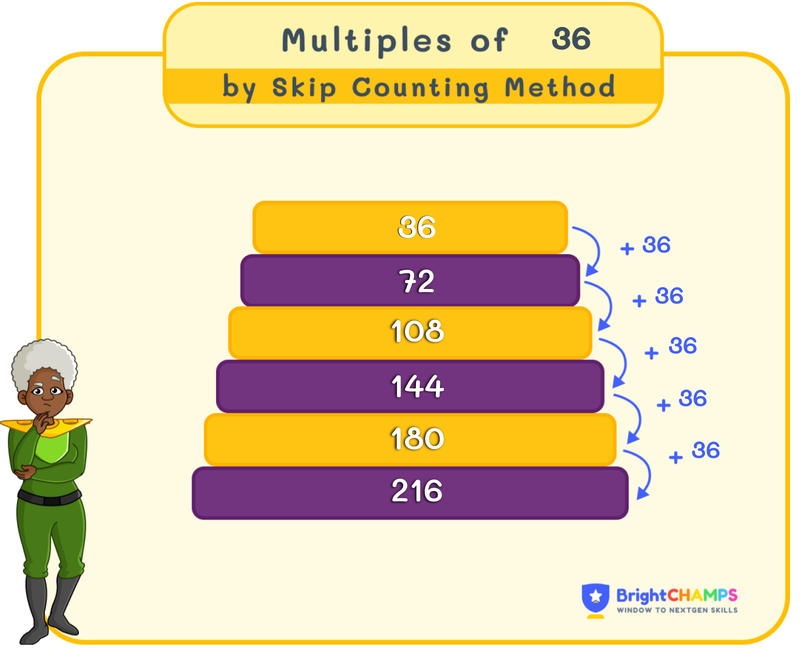
 261 Learners
261 LearnersLast updated on May 26th, 2025

Multiples of 36

In math, multiples are the products we get while multiplying a number with other numbers. Multiples play a key role in construction and design, counting groups of items, sharing resources equally, and managing time effectively. In this topic, we will learn the essential concepts of multiples of 36.
What are the Multiples of 36?
Now, let us learn more about multiples of 36. Multiples of 36 are the numbers you get when you multiply 36 by any whole number, including zero. Each number has an infinite number of multiples, including a multiple of itself.
In multiplication, a multiple of 36 can be denoted as 36 × n, where ‘n’ represents any whole number (0, 1, 2, 3,…). So, we can summarize that:
Multiple of a number = Number × Any whole number
For example, multiplying 36 × 1 will give us 36 as the product. Multiples of 36 will be larger or equal to 36. 
List of First 20 Multiples of 36
Multiples of 36 include the products of 36 and an integer. Multiples of 36 are divisible by 36 evenly. The first few multiples of 36 are given below:
| TABLE OF 36 (1-10) | |
|---|---|
|
36 x 1 = 36 |
36 x 6 = 216 |
|
36 x 2 = 72 |
36 x 7 = 252 |
|
36 x 3 = 108 |
36 x 8 = 288 |
|
36 x 4 = 144 |
36 x 9 = 324 |
|
36 x 5 = 180 |
36 x 10 = 360 |
| TABLE OF 36 (11-20) | |
|---|---|
|
36 x 11 = 396 |
36 x 16 = 576 |
|
36 x 12 = 432 |
36 x 17 = 612 |
|
36 x 13 = 468 |
36 x 18 = 648 |
|
36 x 14 = 504 |
36 x 19 = 684 |
|
36 x 15 = 540 |
36 x 20 = 720 |
Now, we know the first few multiples of 36. They are 0, 36, 72, 108, 144, 180, 216, 252, 288, 324, 360,...
Operations with Multiples of 36
Understanding the multiples of 36 helps solve mathematical problems and boost our multiplication and division skills. When working with multiples of 36, we need to apply it to different mathematical operations such as addition, subtraction, multiplication, and division.
Sum of first 5 Multiples of 36:
36, 72, 108, 144, and 180 are the first five multiples of 36. When multiplying 36 from 1 to 5, we get these numbers as the products.
So, the sum of these multiples is:
36 + 72 + 108 + 144 + 180 = 540
When we add the first 5 multiples of 36, the answer will be 540.
Subtraction of first 5 Multiples of 36:
While we do subtraction, it improves our comprehension of how the value decreases when each multiple is subtracted from the previous one. 36, 72, 108, 144, and 180 are the first five multiples of 36. So, let us calculate it as given below:
36 - 72 = -36
-36 - 108 = -144
-144 - 144 = -288
-288 - 180 = -468
Hence, the result of subtracting the first 5 multiples of 36 is -468.
Average of first 5 Multiples of 36:
To calculate the average, we need to identify the sum of the first 5 multiples of 36, and then divide it by the count, i.e., 5. Because there are 5 multiples presented in the calculation. Averaging helps us understand the concepts of central tendencies and other values. We know the sum of the first 5 multiples of 36 is 540.
36 + 72 + 108 + 144 + 180 = 540
Next, divide the sum by 5:
540 ÷ 5 = 108
108 is the average of the first 5 multiples of 36.
Product of First 5 Multiples of 36:
The product of given numbers is the result of multiplying all of them together. Here, the first 5 multiples of 36 include: 36, 72, 108, 144, and 180. Now, the product of these numbers is:
36 × 72 × 108 × 144 × 180 = 1,361,797,632
The product of the first 5 multiples of 36 is 1,361,797,632.
Division of First 5 Multiples of 36:
While we perform division, we get to know how many times 36 can fit into each of the given multiples. 36, 72, 108, 144, and 180 are the first 5 multiples of 36.
36 ÷ 36 = 1
72 ÷ 36 = 2
108 ÷ 36 = 3
144 ÷ 36 = 4
180 ÷ 36 = 5
The results of dividing the first 5 multiples of 36 are: 1, 2, 3, 4, and 5.

Common Mistakes and How to Avoid Them in Multiples of 36
While working with multiples of 36, we make common mistakes. Identifying these errors and understanding how to avoid them can be helpful. Below are some frequent mistakes and tips to avoid them:

Multiples of 36 Examples

Problem 1
In a park, there are bicycles that can be rented out. Each bicycle has 36 gears. If a group of cyclists rents 5 bicycles, how many gears will they have in total?

180 gears
Explanation
Each bicycle has 36 gears. To find out the total number of gears for 5 bicycles, we multiply 36 by 5.
Number of bicycles = 5
Gears per bicycle = 36
36 × 5 = 180
Therefore, the cyclists will have a total of 180 gears.

Problem 2
A new art exhibit is being set up with sculptures. Each sculpture is made up of 36 individual pieces. If the exhibit includes the first four multiples of 36 in terms of sculptures, how many pieces in total are used?

360 pieces
Explanation
We find the total number of sculptural pieces by using the first four multiples of 36. They are:
36 × 1 = 36
36 × 2 = 72
36 × 3 = 108
36 × 4 = 144
Total pieces = 36 + 72 + 108 + 144 = 360
The exhibit uses a total of 360 pieces.

Problem 3
At a music festival, there are 36 speakers set up across the venue. Each speaker can play a track simultaneously. If each track lasts 3 minutes and they broadcast the first five multiples of 36 tracks in sequence, how long will the broadcast last?

540 minutes
Explanation
The first five multiples of 36 are:
36 × 1 = 36
36 × 2 = 72
36 × 3 = 108
36 × 4 = 144
36 × 5 = 180
Total tracks = 36 + 72 + 108 + 144 + 180 = 540
Since each track lasts 3 minutes, the total broadcast time is 540 minutes.

Problem 4
In a large library, they have a special event where each book shelf holds exactly 36 books. If there are 9 shelves filled with these books, how many books are displayed in total?

324 books
Explanation
To find the total number of books, we multiply the number of shelves by the number of books per shelf.
Number of shelves = 9
Books per shelf = 36
36 × 9 = 324
Hence, there are 324 books displayed in total.

Problem 5
A factory produces toy cars in batches, each batch containing 36 cars. If the factory operates on the first six multiples of 36 batches in a day, how many toy cars are produced in that day?

756 toy cars
Explanation
The first six multiples of 36 are calculated as follows:
36 × 1 = 36
36 × 2 = 72
36 × 3 = 108
36 × 4 = 144
36 × 5 = 180
36 × 6 = 216
Total cars produced = 36 + 72 + 108 + 144 + 180 + 216 = 756
Therefore, the factory produces 756 toy cars in a day.


FAQs on Multiples of 36
1.How do you find the multiples of 36?
2.What is the LCM of 9 and 36?
3.What are the real-life applications of Multiples of 36?
4.Are multiples of 36 finite or infinite?
5.Is there any odd multiples of 36?
6.How can poems help children in Oman memorize the Multiplication Table and Multiples of 36?
7.Can learning the Multiplication Table influence creativity in solving Multiples of 36 challenges for kids in Oman?
8.How do language and cultural differences in Oman affect the way children learn the Multiplication Table and Multiples of 36?
9.What role does brain development play in mastering the Multiplication Table and Multiples of 36 among early learners in Oman?
Important Glossaries for Multiples of 36
- Multiple: A multiple represents the product of a number that may be multiplied by an integer. For example, multiples of 36 include 36, 72, 108, 144, etc.
- Number pattern: This refers to how numbers are listed. It should follow a certain sequence. Multiples of 36 are the numbers that consist of the number pattern of 36.
- Even number: An even number refers to any number that can be divisible by 2 without leaving any remainder. The last digits of even numbers are 0, 2, 4, 6, or 8. All multiples of 36 are even numbers.
- Divisor: It refers to any number by which another number can be divided without leaving any remainder. 1, 2, 3, 4, 6, 9, 12, 18, and 36 are the divisors of 36.
- Least Common Multiple (LCM): The smallest multiple that is exactly divisible by each member of a set of numbers. For example, the LCM of 9 and 36 is 36.
Explore More multiplication-tables
About BrightChamps in Oman


Seyed Ali Fathima S
About the Author
Seyed Ali Fathima S a math expert with nearly 5 years of experience as a math teacher. From an engineer to a math teacher, shows her passion for math and teaching. She is a calculator queen, who loves tables and she turns tables to puzzles and songs.
Fun Fact
: She has songs for each table which helps her to remember the tables




